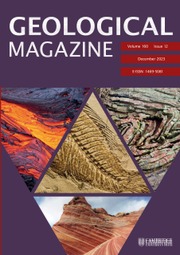Crossref Citations
This article has been cited by the following publications. This list is generated based on data provided by
Crossref.
Pandit, M.K.
Sial, A.N.
Jamrani, S.S.
and
Ferreira, V.P.
2001.
Carbon Isotopic Profile Across the Bilara Group Rocks of Trans-Aravalli Marwar Supergroup in Western India: Implications for Neoproterozoic — Cambrian Transition.
Gondwana Research,
Vol. 4,
Issue. 3,
p.
387.
Felitsyn, S
and
Morad, S
2002.
REE patterns in latest Neoproterozoic–early Cambrian phosphate concretions and associated organic matter.
Chemical Geology,
Vol. 187,
Issue. 3-4,
p.
257.
Kirschvink, Joseph L.
and
Raub, Timothy D.
2003.
A methane fuse for the Cambrian explosion: carbon cycles and true polar wander
.
Comptes Rendus. Géoscience,
Vol. 335,
Issue. 1,
p.
65.
Johannesson, Karen H.
Tang, Jianwu
Daniels, Jeanette M.
Bounds, William J.
and
Burdige, David J.
2004.
Rare earth element concentrations and speciation in organic-rich blackwaters of the Great Dismal Swamp, Virginia, USA.
Chemical Geology,
Vol. 209,
Issue. 3-4,
p.
271.
Pittau, Paola
Cotza, Francesca
Cristini, Sandro
Rio, Myriam Del
and
Loi, Marilisa
2006.
Palaeontologic and biogeochemical characterization of the
Cyrtograptus lundgreni
event in the black shales of eastern Mid‐Sardinia, Italy
.
Lethaia,
Vol. 39,
Issue. 2,
p.
111.
Felitsyn, S. B.
2006.
The content of gold in Vendian-Cambrian phosphorite concretions from the East European Platform.
Lithology and Mineral Resources,
Vol. 41,
Issue. 5,
p.
417.
Felitsyn, S. B.
2006.
Alkali earth elements in Vendian-Cambrian clayey rocks, the East European Platform.
Lithology and Mineral Resources,
Vol. 41,
Issue. 4,
p.
362.
Felitsyn, S. B.
2008.
Gold in Vendian-Cambrian organic macrofossils of the East European platform.
Lithology and Mineral Resources,
Vol. 43,
Issue. 6,
p.
542.
Pi, Dao-Hui
Liu, Cong-Qiang
Shields-Zhou, Graham A.
and
Jiang, Shao-Yong
2013.
Trace and rare earth element geochemistry of black shale and kerogen in the early Cambrian Niutitang Formation in Guizhou province, South China: Constraints for redox environments and origin of metal enrichments.
Precambrian Research,
Vol. 225,
Issue. ,
p.
218.
Tarhan, Lidya G.
Hughes, Nigel C.
Myrow, Paul M.
Bhargava, Om N.
Ahluwalia, Arun D.
Kudryavtsev, Anatoliy B.
and
Donoghue, Philip
2014.
Precambrian–Cambrian boundary interval occurrence and form of the enigmatic tubular body fossil Shaanxilithes ningqiangensis from the Lesser Himalaya of India.
Palaeontology,
Vol. 57,
Issue. 2,
p.
283.
Gubanov, Alexander P.
and
Bogolepova, Olga K.
2014.
Early Ordovician molluscs with preserved colour pattern from the Timan-Pechora Basin of Russia.
GFF,
Vol. 136,
Issue. 1,
p.
85.
Moczydłowska, Małgorzata
Westall, Frances
and
Foucher, Frédéric
2014.
Microstructure and Biogeochemistry of the Organically Preserved Ediacaran MetazoanSabellidites.
Journal of Paleontology,
Vol. 88,
Issue. 2,
p.
224.
Felitsyn, S. B.
and
German, T. N.
2015.
Carbon isotope signatures of Neoproterozoic and Early Cambrian organic fossils from Siberian and East European platforms.
Paleontological Journal,
Vol. 49,
Issue. 3,
p.
221.
Guo, Qingjun
Deng, Yinan
Hippler, Dorothee
Franz, Gerhard
and
Zhang, Junming
2016.
REE and trace element patterns from organic-rich rocks of the Ediacaran–Cambrian transitional interval.
Gondwana Research,
Vol. 36,
Issue. ,
p.
94.
Felitsyn, S. B.
and
Alfimova, N. A.
2019.
Carbon Isotope Composition and Concentration of Fe-Group Elements in the Sedimentary Organic Matter from Rocks of Different Ages.
Paleontological Journal,
Vol. 53,
Issue. 7,
p.
757.
Felitsyn, Sergey B
and
Bogomolov, Eugeny S.
2020.
Nd isotope composition of the Ediacaran and earliest Cambrian phosphorite nodules and Fe sulphide from the East European Platform.
Geological Magazine,
Vol. 157,
Issue. 12,
p.
2081.
Zhang, Kun
and
Shields, Graham A.
2022.
Sedimentary Ce anomalies: Secular change and implications for paleoenvironmental evolution.
Earth-Science Reviews,
Vol. 229,
Issue. ,
p.
104015.
Lehn, Ilana
Paim, Paulo Sérgio Gomes
and
Chemale, Farid
2024.
From the sea to the land: How microbial mats dominated marine and continental environments in the Ediacaran Camaquã Basin, Brazil.
Geosystems and Geoenvironment,
Vol. 3,
Issue. 3,
p.
100283.

